Abstract
Mineral oil–based liquids are normally used as the dielectric fluid in electrical discharge machining (EDM) where it has the ability in improving the efficiency of the machining process. Nevertheless, these dielectric fluids have the tendency to cause environmental problems. Therefore, as an alternative, gas has been introduced as the dielectric fluid also known as dry EDM (DEDM) process. However, kerf variation in dry micro-wire EDM (DμWEDM) process remains a critical issue. Thus, the objective of this research is to investigate kerf accuracy in DμWEDM. Experimental investigation was carried out on a stainless steel (SS304) with a tungsten wire as the electrode and compressed air as the dielectric fluid using integrated multi-process machine tool, DT 110 (Mikrotools Inc., Singapore). Central composite design (CCD) was used to design the experiment using two controlled parameters: capacitance and gap voltage. Analysis of variance (ANOVA) was used to analyse the results and to evaluate the adequacy of the developed model. The results were obtained by measuring the kerf using a scanning electron microscope (SEM) (JEOL JSM-5600, Japan). The investigation of kerf was divided into two responses which were upper kerf and bottom kerf. Empirical models were developed, and it was found that both parameters (capacitance and gap voltage) have high influence on both responses. The optimum parameters for both minimum upper and bottom kerf were found to be 0.1 nF capacitance and 91 V gap voltage. The developed models were found to be adequate since the percentage error is relatively small (< 3%).







Similar content being viewed by others
References
Banu A, Ali MY, Rahman MA, Konneh M (2019) Investigation of process parameters for stable dry micro wire electrical discharge machining. Int J Adv Manuf Technol 103(1-4):723–741
Hoang KT, Yang SH (2013) A study on the effect of different vibration-assisted methods in micro-WEDM. J Mater Process Technol 213:1616–1622
Hoang KT, Yang SH (2015a) A new approach for micro-WEDM control based on real-time estimation of material removal rate. Int J Precis Eng Manuf 16(2):241–246
Azhiri RB, Teimouri R, Baboly MG, Laseman Z (2014) Application of Taguchi, ANFIS and grey relational analysis for studying, modelling and optimization of wire EDM process while using gaseous media. Int J Adv Manuf Technol 71(1):279–295
Khatri BC, Rathod P, Valaki JB (2016) Ultrasonic vibration-assisted electric discharge machining: a research review. Proceedings of the Institution of Mechanical Engineers, Part B: J Eng Manuf:1–12
Wang T, Xie SQ, Xu XC, Chen Q, Lu XC, Zhou SH (2012) Application of uniform design in experiments of WEDM in gas. Adv Mater Res 426:11–14
Ali MY, Banu A, Rahman MA, Hazza M, Adesta EYT (2018a) Precision control of kerf in metal cutting using dry micro WEDM: issues and challenges. Key Eng Mater 775:499–505
Kunieda M, Furudate C (2001) High precision finish cutting by dry WEDM. CIRP Ann Manuf Technol 50(1):121–124
Banu A, Ali MY (2016) Electrical discharge machining (EDM): a review. Int J Eng Mater Manuf 1(1):3–10
Zhang QH, Zhang JH, Ren SF, Deng JX, Ai X (2004) Study on technology of ultrasonic vibration aided electrical discharge machining in gas. J Mater Process Technol 149:640–644
Fujiki M, Ni J, Shih AJ (2011) Tool path planning for near-dry EDM milling with lead angle on curved surfaces. J Manuf Sci Eng 133(5):051005
Paul G, Roy S, Sarkar S, Hanumaiah N, Mitra S (2013) Investigations on influence of process variables on crater dimensions in micro-EDM of titanium aluminide alloy in dry and oil dielectric media. Int J Adv Manuf Technol 65:1009–1017
Skrabalak G, Kozak J (2010) Study on dry electrical discharge machining. Wear 5:7
Yu Z, Jun T, Masanori K (2004) Dry electrical discharge machining of cemented carbide. J Mater Process Technol 149(1):353–357
Abbas MN, Solomon DG, Fuad Bahari M (2007) A review on current research trends in electrical discharge machining (EDM). Int J Mach Tools Manuf 47(7):1214–1228
Wang T, Kunieda M (2004) Dry WEDM for finish cut. Key Eng Mater 259-260:562–566
Ghodsiyeh D, Moradi M (2015) Wire electrical discharge machining. In: Jahan MP (ed) Electrical discharge machining (EDM) types, technologies and applications. Nova Science Publishers, Inc., New York, pp 33–65
Ho KH, Newman ST, Rahimifard S, Allen RD (2004) State of the art in wire electrical discharge machining (WEDM). Int J Mach Tools Manuf 44:1247–1259
Banu A, Bakar MA, Ali MY, Adesta EY (2017) Analysis of WEDM process parameters on surface roughness and kerf using Taguchi method. Int J Eng Mater Manuf 2(4):103–109
Hoang KT, Yang SH (2015b) Kerf analysis and control in dry micro-wire electrical discharge machining. Int J Adv Manuf Technol 78:1803–1812
Di S, Chu X, Wei D, Wang Z, Chi G, Liu Y (2009) Analysis of kerf width in micro-WEDM. Int J Mach Tools Manuf 49(10):788–792
Okada A, Uno Y, Onoda S, Habib S (2009) Computational fluid dynamics analysis of working fluid flow and debris movement in wire EDMed kerf. CIRP Annals-Manuf Technol 58(1):209–212
Zhu Y, Antao DS, Chu KH, Chen S, Hendricks TJ, Zhang T, Wang EN (2016) Surface structure enhanced microchannel flow boiling. J Heat Transf 138:091501
Akkurt A (2009) Surface properties of the cut face obtained by different cutting methods from AISI 304 stainless steel materials. Indian J Eng Mater Sci 16:373–384
Maher I, Sarhan AAD, Hamdi M (2015) Review of improvements in wire electrode properties for longer working time and utilization in wire EDM machining. Int J Adv Manuf Technol 76:329–351
Le Man H, Behera SK, Park HS (2010) Optimization of operational parameters for ethanol production from Korean food waste leachate. Int J Environ Sci Technol 7(1):157–164
Adebisi AA, Ndaliman MB (2015, October) Mathematical modelling of stir casting process parameters for AlSiCp composite using central composite design. In: Paper presented at Proceedings of the 28th AGM and International Conference of the Nigerian Institution for Mechanical Engineers organized by The Nigerian Institution for Mechanical Engineers. Nigeria, Abuja City
Gupta K, Jain NK (2017) Planning, design and details of experimental investigation. In: Near-net shape manufacturing of miniature spur gears by wire spark erosion machining. Materials Forming, Machining and Tribology. Springer, Singapore, pp 35–55
Montgomery DC (2012) Design and analysis of experiments, 8th edn. John Wiley and Sons, Inc., United States of America
Mammar K, Chaker A (2013) A central composite face-centered design for parameters estimation of PEM fuel cell electrochemical model. Leonardo J Sci 23:84–96
Castillo ED (2007) Process optimization: a statistical approach. Springer, United States of America
Ndaliman MB, Khan AA, Ali MY, Wahid Z (2013) Determination of influential factors on EDMed surface properties using Placket-Burman design. World Appl Sci J 21:88–93
Ali MY, Banu A, Salehan M, Adesta EYT, Hazza M, Shaffiq M (2018b) Dimensional accuracy in dry micro wire electrical discharge machining. J Mech Eng Sci 12(1):3321–3329
Khademi A, Renani NG, Mofarrahi M, Jeddi AR, Yusof NM (2013) The best location for speed bump installation using experimental design methodology. Promet – Traffic & Transportation 25(6):565–574
Omar WW, Nordin N, Mohamed M, Amin NAS (2009) A two-step biodiesel production from waste cooking oil: optimization of pre-treatment step. J Appl Sci 9(17):3098–3103
Montgomery DC (2005) Design and Analysis of Experiments, 6th edn. John Wiley and Sons, Inc., United States of America
Ndaliman MB, Al-Hazza MHF, Khan AA, Ali MY (2014) Modelling surface roughness of Ti6Al4V alloy subjected to EDM with Cu-TaC electrode using response surface methodology. Retrieved from https://www.researchgate.net/publication/321070863_Modeling_surface_roughness_of_Ti6Al4V_alloy_subjected_to_EDM_with_Cu-TaC_electrode_using_response_surface_methodology dated on 12 February 2017.
Balan ASS, Giridharan A (2017) A progress review in wire electrical discharge machining process. International Journal of Automotive and Mechanical Engineering 14:4097–4124
Conde A, Arriandiaga A, Sanchez JA, Portillo E, Plaza S, Canabes I (2018) High-accuracy wire electrical discharge machining using artificial networks and optimization techniques. Robot Comput Integr Manuf 49:24–38
Takahata K (2009) Micro-electro-discharge machining technologies for MEMS. In: Micro electronic and mechanical systems. InTech
Tomura S, Kunieda M (2009) Analysis of electromagnetic force in wire-EDM. Precis Eng 33:255–262
Macedo FTB, Wiessner M, Hollenstein C, Esteves PMB, Wegener K (2016a) Fundamental investigation of dry electrical discharge machining (DEDM) by optical emission spectroscopy and its numerical interpretation. International Journal of Advanced Manufacturing Technology:1–13
Macedo FTB, Wiessner M, Hollenstein C, Kuster F, Wegener K (2016b) Investigation of the fundamentals of tool electrode wear in dry EDM. Procedia CIRP 46:55–58
Radmilovic-Radjenovic M, Radjenovic B (2017) The effect of the field emission on the breakdown voltage characteristics of nitrogen microdischarges. International Journal of Engineering Innovation and Research 6(6):280–283
Roth R, Balzer H, Kuster F, Wegener K (2012) Influence of the anode material on the breakdown behavior in dry electrical discharge machining. Procedia CIRP 1:639–644
Wiessner M, Macedo FTB, Martendal CP, Kuster F, Wegener K (2018) Fundamental investigation of EDM plasmas, part I: a comparison between electric discharges in gaseous and liquid dielectric media. Procedia CIRP 68:330–335
Li Y (2014) Analysis of ion-enhanced field emission and field emission-driven microdischarges (doctor of philosophy’s dissertation). Notre Dame University, Notre Dame, Indiana.
Ali MY, Liew WYH, Gure SA, Asfana B (2012) Influence of energy parameters of micro WEDM on kerf. Adv Mater Res 576:527–530
Acknowledgements
The authors are thankful to the faculty and staff at Micromanufacturing Laboratory and Metallographic Laboratory at IIUM for their support.
Funding
This research was funded by MOSTI, under Research Grant SF15-016-0066.
Author information
Authors and Affiliations
Corresponding author
Additional information
Publisher’s note
Springer Nature remains neutral with regard to jurisdictional claims in published maps and institutional affiliations.
Rights and permissions
About this article
Cite this article
Ali, M.Y., Banu, A. & Al Hazza, M.H. Analysis of kerf accuracy in dry micro-wire EDM. Int J Adv Manuf Technol 111, 597–608 (2020). https://doi.org/10.1007/s00170-020-06095-y
Received:
Accepted:
Published:
Issue Date:
DOI: https://doi.org/10.1007/s00170-020-06095-y




